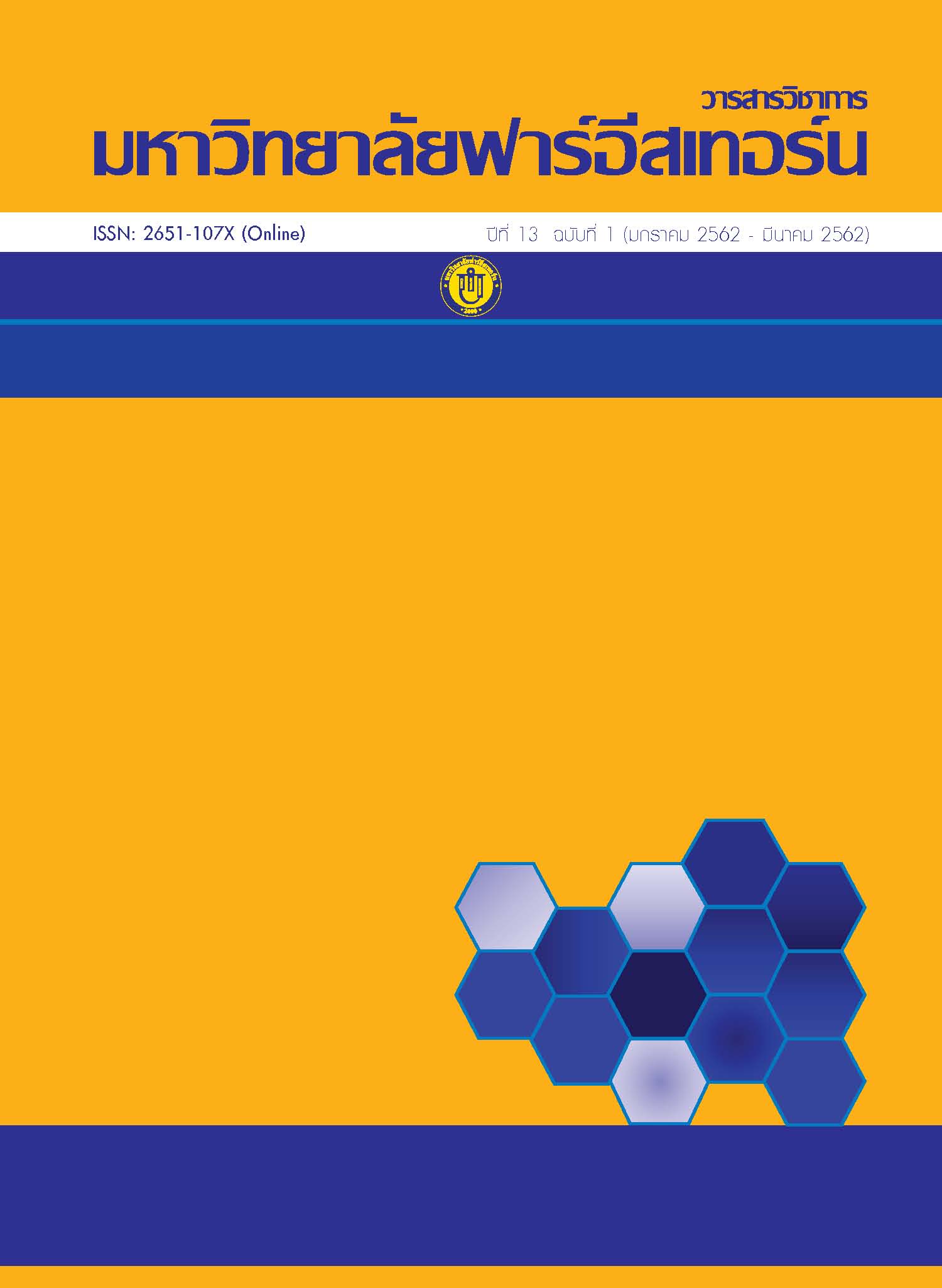Development Indicators Instructional Competency of Teachers in Multi-Ethnic Classrooms
Main Article Content
Abstract
The purpose of this research was to analyze the factors and indicators of teaching competency of teacher in ethnic diversity classroom. It would provide the students characteristics of acceptance of multicultural, respect the right of others and cohabitation in a multicultural society of 3 groups were 1) text book, research, and 20 related articles using purposive sampling to analyze the indicators of teaching competency. 2) 9 Lecturers from Chiang Mai University and Chiang Mai Rajabhat University who are interested in teaching and learning about ethnic group, by using purposive sampling. 3) 900 students in ethnic diversity classrooms from secondary schools in Chiang Mai, Chiang Rai and Tak by using stratified random sampling method. This group of sample was use for exploratory factor analysis of teaching competency in ethnic diversity classrooms. The research tools were 1) teaching behavior analysis form 2) the questionnaire on suitability indicators of teacher behavior and 3) the questionnaire on teaching behavior in ethnic diversity classroom. Data was analyzed using content analysis, average, standard deviation and exploratory factor analysis (EFA).
The results of the study showed that the 4 factors of teaching competency in ethnic diversity classroom were 1) ethnic student rights respecting 2) teaching technique in ethnic diversity classroom 3) the creation of identity and 4) understanding ethnic student. The indicators of teaching behavior consist of 35 items which describe the characteristic of each factor.
Article Details
1. Any views and comments in the Journal of Social Innovation and Lifelong Learning are the authors’ views. The editorial staff have not to agree with those views and it is not considered as the editorial’s responsibility.
2. The responsibility of content and draft check of each article belongs to each author. In case, there is any lawsuit about copyright infringement. It is considered as the authors’ sole responsibility.
3. The article copyright belonging to the authors and The Far Eastern University are copyrighted legally. Republication must be received direct permission from the authors and The Far Eastern University in written form.
References
กองบรรณาธิการ คณะกรรมการคาทอริกเพื่อการพัฒนาสังคม แผนกลุ่มชาติพันธุ์. (2553). การละเมิดสิทธิมนุษยชนกลุ่มชาติพันธุ์และชนเผ่าในประเทศไทย. ชนเผ่าพื้นเมือง. 30(16), 30-38.
Editorial committee of Catholic commission for ethnic group (2010). Violation of Human Rights, Ethnic and Tribal Groups in Thailand. Native tribe. 30(16), 30-38.
ขวัญชีวัน บัวแดง ปนัดดา ปุณยสาระนัย และ ประสิทธิ์ ลีปรีชา. (2546). วิถีชีวิตชาติพันธุ์ในเมือง. เชียงใหม่: มิ่งเมือง.
Kwancheewan Buadeang, Panadda Punyasaranai, and Prasit Leepreecha.(2003 ). The Way of Life of Ethnic Group in The City. Chiang Mai: Ming Muang.
เงาศิลป์ คงแก้ว สมนึก เบญจวิทยาธรรม สุวิชานนท์ รัตนภิมล (บรรณาธิการ). มปป. ชีวิตบนเส้นด้ายของ13 เผ่าไทย. เอกสารอัดสำเนา.
Ngaosilp Kongkaew, Somnuek Benjawittayatham, and Suwichanon Rattanapimol (editors). n.d. 13 Thai Tribes, Life Hangs by a Thread. Mimeographed.
ชูพินิจ เกษมณี. (2555). ความหลากหลายทางวัฒนธรรมในสังคมพหุลักษณ์ Cultural Diversity in Pluralistic Society. กรุงเทพฯ : มปพ.
Chupinit Kesmanee. (2012). Cultural Diversity in Pluralistic Society. Bangkok: n.p.
บัญญัติ ยงย่วน. (2550). การใช้กิจกรรมศิลปะเพื่อส่งเสริมการยอมรับความหลากหลายในสังคมพหุวัฒนธรรม. ปัตตานี: มหาวิทยาลัยสงขลานครินทร์ วิทยาเขตปัตตานี.
Banyat Yongyuan. (2007). Using Art Activities to Encourage Diversity Acceptance in Multicultural Society. Pattanee: Prince of Songkla University, Pattanee Campus.
บัญญัติ ยงย่วน ปนัดดา ธนเศรษฐกร และ วสุนันท์ ชุ่มเชื้อ. (2553). การพัฒนารูปแบบการจัดการศึกษาพหุวัฒนธรรมในโรงเรียนประถมศึกษา. กรุงเทพฯ: สถาบันแห่งชาติเพื่อการพัฒนาเด็กและครอบครัว มหาวิทยาลัยมหิดล
Banyat Yongyuan, Panadda Tanasettakorn, and Vasunun Chumchua. (2010). A development of Multicultural Education Model in Elementary School. Bangkok: National Institute for Child and Family Development, Mahidol University.
บุบผา อนันต์สุชาติกุล. (2554). รูปแบบและการจัดการศึกษาสำหรับทายาทรุ่นที่สองของผู้ย้ายถิ่นจากประเทศพม่า. เอกสารอัดสำเนา
Buppa Anansuchatkul. (2011). Education models for The Second Generation Migrants From Myanmar. Mimeographed.
สมพงษ์ ดุลยอนุกิจ. (2549). สังคมศาสตร์กับการพัฒนา. กรุงเทพฯ: โอเดียนสโตร์.
Sompong Dullaya-Anuki. (2006). Social Science and Development. Bangkok: Odeon Store.
สำนักงานคณะกรรมการการศึกษาแห่งชาติ. (2545). แผนการศึกษาแห่งชาติ (พ.ศ. 2545-2549). กรุงเทพฯ: พริกหวานกราฟฟิค.
Office of the National Education Commission. (2002). National Education Plan (2002-2006). Bangkok: Prikwan Graphic.
สำนักงานเลขาธิการสภาการศึกษา. (2556). บทวิเคราะห์สถานภาพการพัฒนาครูทั้งระบบและข้อเสนอแนะแนวทางการพัฒนาครูเพื่อคุณภาพผู้เรียน. กรุงเทพฯ: พริกหวาน กราฟฟิค.
Office of the Education Council. (2013). Review on the Status of Whole System Teacher Development and Suggestion for Teacher Development to Improve Student Quality. Bangkok: Prikwan Graphic.
สำนักงานเลขาธิการสภาการศึกษา. (2551). สภาพปัจจุบัน ปัญหา และแนวโน้มบริบทการเปลี่ยนแปลงสังคมโลกและสังคมไทย ภายใต้กระแสโลกาภิวัตน์ ด้านประชากร. กรุงเทพฯ: พริกหวานกราฟฟิค จำกัด.
Office of the Education Council. (2008). The State, Problems and Trends of Changing World Society and Thai Society under Globalization in Population. Bangkok: Prikwan Graphic.
อรทัย ชื่นมนุษย์. (2516). จิตวิทยาอคติ Psychology of Prejudice. กรุงเทพฯ: มหาวิทยาลัยรามคำแหง.
Orathai Chuenmanus. (1973). Psychology of Prejudice. Bangkok: Ramkamhaeng University.
Allen J., and Labbo, L. (2001). Giving It Second Thought: Making Culturally Engaged Teachingculturally Engaging. Language Arts. 79(1), 40-50.
Burton Lorelie. (2005). Understanding Students Diversity and Factors that Influence Academic Success: A Preliminary Study. Retrieved July 1, 2011, from: http://www.infoagepub.com /products /series/titles/1-59311-4.html
Jared Keengwe. (2010). Fostering cross Cultural Competence in Pre-service Teachers through Multicultural Education Experiences . Retrieved July 26, 2011, from:http://www.springerlink.com/ content/1g64056025840xkj.
Manning M. L. and Baruth L. G. (2004). Multicultural Education of Children and Adolescents. (4th ed.). Boston: Peason.
Vescio V., Bondy E., and Poekert P. (2009). Prepare Multicultural Teacher Educators: Toward a Pedagogy Transformation. Teacher Education Quarterly. 36(2), 5-24.

